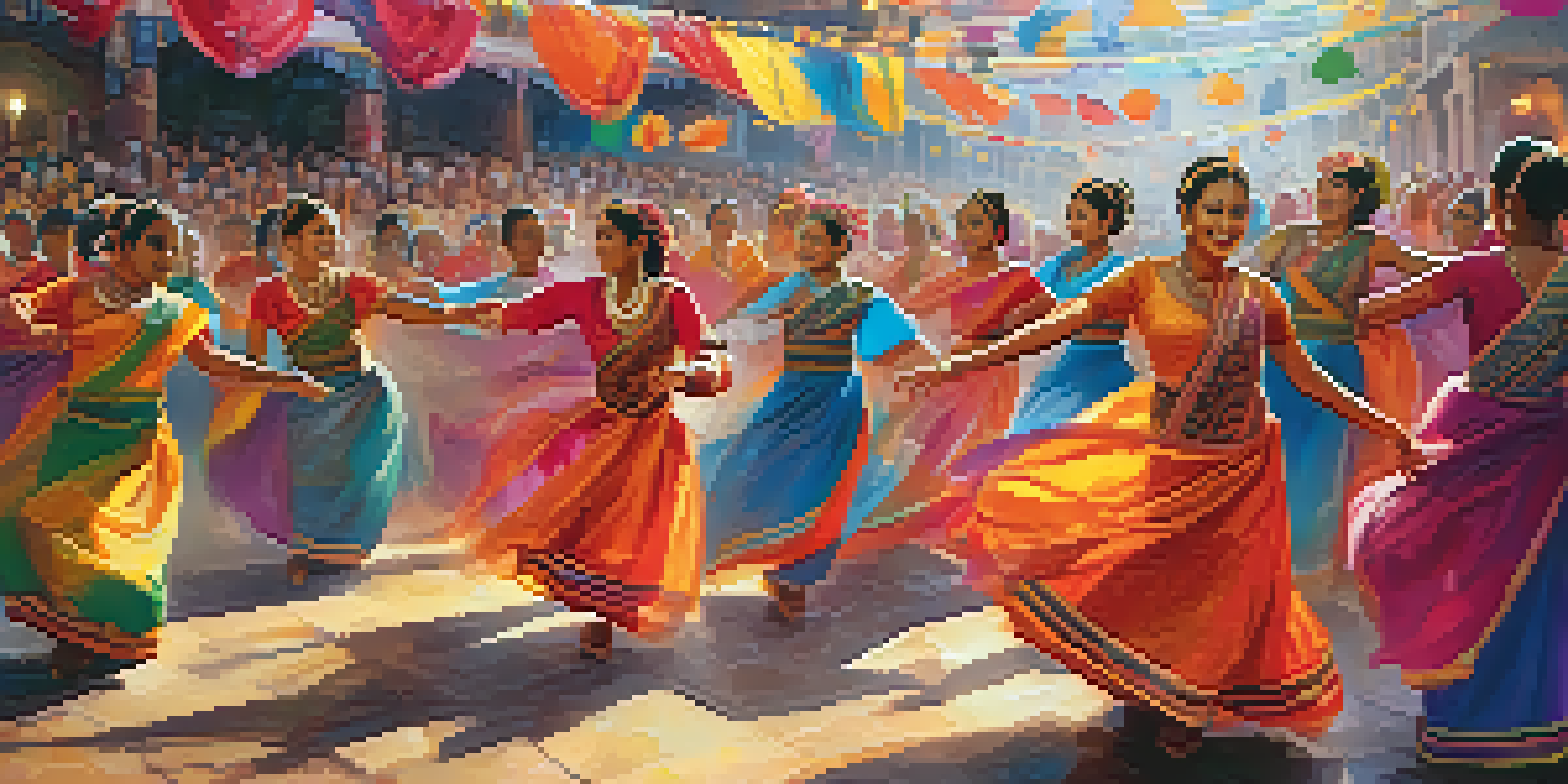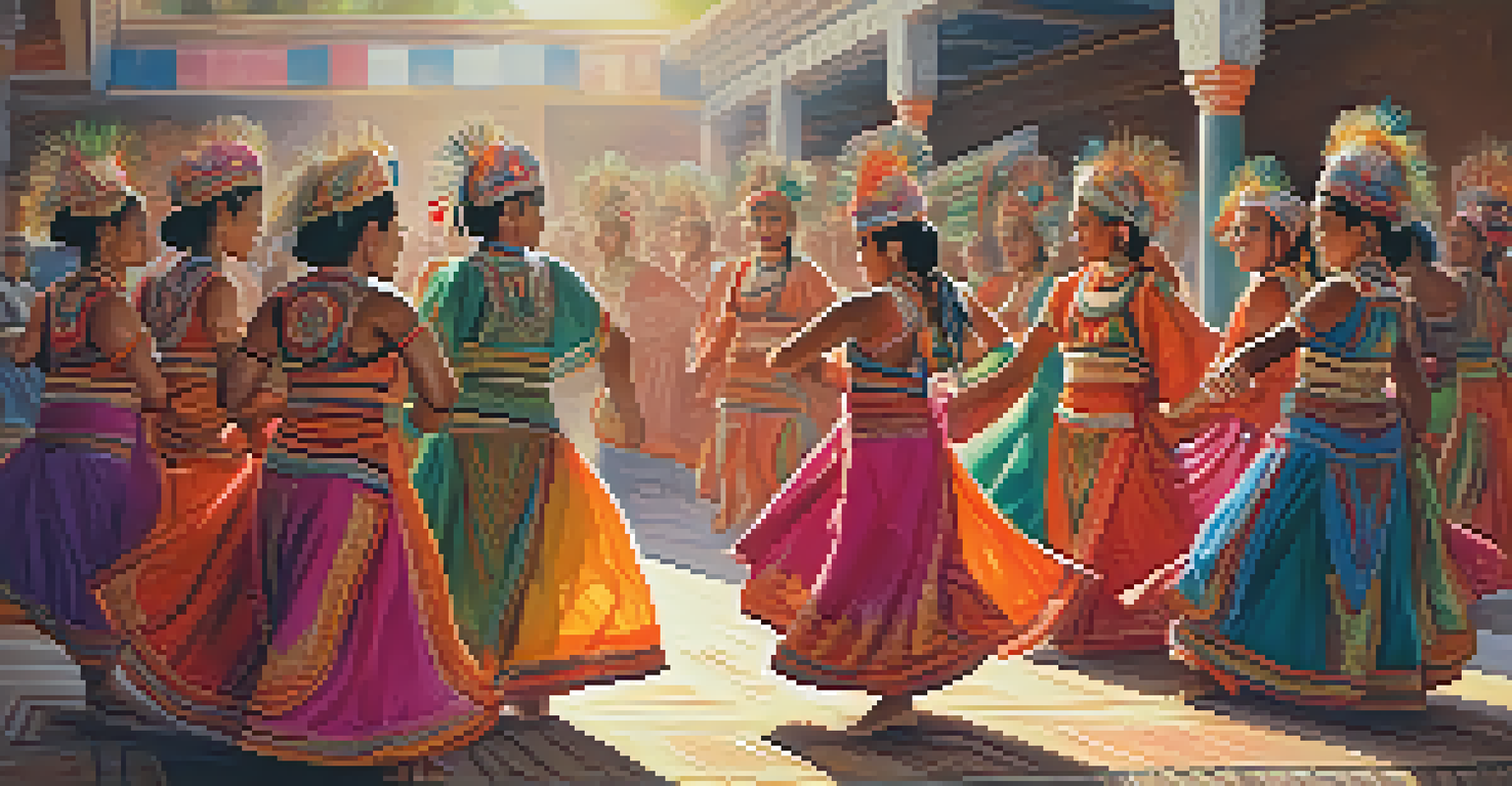Dance as a Means of Storytelling in Cultural Celebrations

The Universal Language of Dance in Celebrations
Dance is often described as a universal language; it transcends words and connects people on an emotional level. In many cultures, dance is a vital part of celebrations, acting as a medium through which stories, traditions, and values are communicated. Whether it's a wedding, festival, or religious ceremony, dance brings a unique vibrancy that enhances the overall experience.
Dance is the hidden language of the soul.
For instance, during the Diwali festival in India, various traditional dances depict the triumph of light over darkness, showcasing the rich tapestry of Hindu mythology. These movements not only entertain but also educate participants and audiences about cultural narratives. In this way, dance becomes a living history lesson, helping to preserve and pass on customs through generations.
Moreover, the communal aspect of dance fosters a sense of belonging and unity among participants. When people come together to dance, they actively engage in the shared storytelling experience, creating bonds that celebrate their heritage and identity. This powerful connection highlights the importance of dance in cultural celebrations.
Embodying Myths and Legends Through Movement
Many dances are inspired by myths and legends, serving as a captivating way to retell ancient stories. For instance, the Native American powwow often features dances that honor ancestral spirits and celebrate tribal history. Each movement is symbolic, reflecting the values and beliefs of the community, while simultaneously engaging the audience in the storytelling process.

In African cultures, traditional dances are often performed to narrate the tales of heroes, gods, and the natural world. These performances are not merely for show; they convey deep meanings and morals, teaching younger generations about their roots. The rhythms and movements evoke emotions, drawing spectators into the narrative and allowing them to experience the stories firsthand.
Dance as a Cultural Connector
Dance serves as a universal language that fosters emotional connections and cultural storytelling during celebrations.
By embodying these legends through dance, performers keep their cultural heritage alive. This practice not only reinforces community identity but also allows the stories to evolve, as new interpretations of age-old tales emerge. Thus, dance becomes a dynamic form of storytelling, rich with cultural significance.
Rituals and Rites: Dance's Role in Cultural Identity
In many cultures, dance plays a crucial role in rituals and rites of passage, marking significant life events such as birth, marriage, and death. These dances often serve as a way to honor ancestors, celebrate achievements, or seek blessings for the future. By participating in these rituals, community members reaffirm their cultural identity and shared beliefs.
Dancing is like dreaming with your feet.
For example, the coming-of-age ceremony in various Indigenous cultures often includes traditional dance, symbolizing the transition from childhood to adulthood. Each movement reflects the values and teachings of the community, helping the youth internalize their heritage. This connection to dance reinforces their identity and encourages pride in their cultural background.
Moreover, these dances serve as a reminder of the continuity of traditions, bridging the past with the present. As community members gather to celebrate these milestones through dance, they collectively strengthen their cultural ties, ensuring that their stories and customs endure for future generations.
Dance Festivals: A Celebration of Cultural Diversity
Dance festivals are a vibrant showcase of cultural diversity, where various communities come together to celebrate their unique traditions. These events often feature performances that highlight the distinct styles and stories of different cultures, offering a rich tapestry of movement and music. They provide an opportunity for cultural exchange, fostering understanding and appreciation among diverse audiences.
For instance, the Edinburgh Festival Fringe attracts performers from around the world, presenting an array of dance styles—from traditional folk dances to contemporary interpretations. This melting pot of cultures allows attendees to experience stories from various backgrounds, broadening their perspectives and encouraging dialogue. Such festivals not only entertain but also educate, celebrating the beauty of cultural diversity.
Myths and Legends in Movement
Traditional dances embody myths and legends, preserving community values and engaging audiences in shared narratives.
Moreover, dance festivals can foster collaboration and innovation, as artists blend different styles and narratives. This creative fusion often leads to the emergence of new forms of storytelling that reflect the evolving nature of culture itself. In this way, dance festivals not only preserve traditions but also create space for new stories to be told.
The Impact of Globalization on Traditional Dance Forms
Globalization has significantly influenced traditional dance forms, leading to both preservation and transformation. While some cultural dances face the risk of fading away, others have found new life as they adapt to contemporary influences. This evolution can enhance the storytelling aspect of dance, making it more relevant to modern audiences.
For example, hip-hop has incorporated elements from various traditional dances, creating a fusion that resonates with younger generations. This blend of styles allows for new narratives to emerge, as dancers reinterpret cultural stories through a modern lens. However, it's essential to approach these adaptations with respect to the original traditions and cultural significance.
Ultimately, globalization presents both challenges and opportunities for traditional dance forms. While some may argue that commercialization dilutes authenticity, others see it as a chance for cultural exchange and revitalization. The key is to balance innovation with respect for the roots of these dances, ensuring that the stories they tell remain meaningful and true.
Dance as a Tool for Social Change and Awareness
Dance has long been a powerful tool for social change, often used to raise awareness about pressing issues. Through movement, performers can convey emotions and messages that resonate deeply with audiences, sparking conversations and inspiring action. This ability to tell stories of struggle, resilience, and hope makes dance an impactful medium for advocacy.
For instance, many contemporary dance companies create works that address social justice issues, using their performances to highlight themes like inequality and environmental concerns. These dances often blend storytelling with powerful visuals, engaging audiences on both emotional and intellectual levels. By doing so, they invite viewers to reflect on their own roles in society and the changes needed.
Dance's Evolving Role in Society
The future of dance is shaped by globalization and technology, allowing for innovative storytelling while respecting cultural roots.
Moreover, community-based dance initiatives often empower marginalized voices, allowing individuals to share their stories through movement. This not only fosters a sense of belonging but also amplifies the narratives that might otherwise go unheard. In this way, dance becomes a catalyst for dialogue and change, illustrating the profound connection between art and activism.
The Future of Dance in Cultural Storytelling
As we look toward the future, the role of dance in cultural storytelling continues to evolve. With advancements in technology and new platforms for sharing performances, dance can reach wider audiences than ever before. This increased visibility allows for a richer exchange of cultural narratives, as artists share their unique stories with the world.
Moreover, the blending of traditional and contemporary styles will likely continue, creating innovative forms of expression that reflect the complexities of modern life. This fusion can enrich storytelling in dance, allowing performers to explore diverse themes and connect with audiences on multiple levels. As a result, we may see the emergence of entirely new dance forms that honor cultural heritage while embracing change.

Ultimately, the future of dance in cultural storytelling is bright. By celebrating diversity and encouraging collaboration, we can ensure that dance remains a vibrant medium for sharing stories, fostering understanding, and building connections across cultures. As we continue to dance through life, we carry with us the narratives that shape who we are.